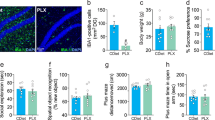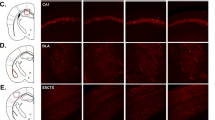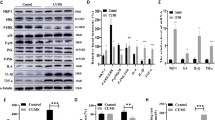Abstract
The limited success in understanding the pathophysiology of major depression may result from excessive focus on the dysfunctioning of neurons, as compared with other types of brain cells. Therefore, we examined the role of dynamic alterations in microglia activation status in the development of chronic unpredictable stress (CUS)-induced depressive-like condition in rodents. We report that following an initial period (2–3 days) of stress-induced microglial proliferation and activation, some microglia underwent apoptosis, leading to reductions in their numbers within the hippocampus, but not in other brain regions, following 5 weeks of CUS exposure. At that time, microglia displayed reduced expression of activation markers as well as dystrophic morphology. Blockade of the initial stress-induced microglial activation by minocycline or by transgenic interleukin-1 receptor antagonist overexpression rescued the subsequent microglial apoptosis and decline, as well as the CUS-induced depressive-like behavior and suppressed neurogenesis. Similarly, the antidepressant drug imipramine blocked the initial stress-induced microglial activation as well as the CUS-induced microglial decline and depressive-like behavior. Treatment of CUS-exposed mice with either endotoxin, macrophage colony-stimulating factor or granulocyte-macrophage colony-stimulating factor, all of which stimulated hippocampal microglial proliferation, partially or completely reversed the depressive-like behavior and dramatically increased hippocampal neurogenesis, whereas treatment with imipramine or minocycline had minimal or no anti-depressive effects, respectively, in these mice. These findings provide direct causal evidence that disturbances in microglial functioning has an etiological role in chronic stress-induced depression, suggesting that microglia stimulators could serve as fast-acting anti-depressants in some forms of depressive and stress-related conditions.
This is a preview of subscription content, access via your institution
Access options
Subscribe to this journal
Receive 12 print issues and online access
$259.00 per year
only $21.58 per issue
Buy this article
- Purchase on Springer Link
- Instant access to full article PDF
Prices may be subject to local taxes which are calculated during checkout





Similar content being viewed by others
References
Manji HK, Drevets WC, Charney DS . The cellular neurobiology of depression. Nat Med 2001; 7: 541–547.
Nestler EJ, Barrot M, DiLeone RJ, Eisch AJ, Gold SJ, Monteggia LM . Neurobiology of depression. Neuron 2002; 34: 13–25.
Belmaker RH, Agam G . Major depressive disorder. N Engl J Med 2008; 358: 55–68.
Rajkowska G, Miguel-Hidalgo JJ . Gliogenesis and glial pathology in depression. CNS Neurol Disord Drug Targets 2007; 6: 219–233.
Banasr M, Duman RS . Glial loss in the prefrontal cortex is sufficient to induce depressive-like behaviors. Biol Psychiatry 2008; 64: 863–870.
Cotter D, Mackay D, Landau S, Kerwin R, Everall I . Reduced glial cell density and neuronal size in the anterior cingulate cortex in major depressive disorder. Arch Gen Psychiatry 2001; 58: 545–553.
Tremblay ME, Stevens B, Sierra A, Wake H, Bessis A, Nimmerjahn A . The role of microglia in the healthy brain. J Neurosci 2011; 31: 16064–16069.
Kettenmann H, Hanisch UK, Noda M, Verkhratsky A . Physiology of microglia. Physiol Rev 2011; 91: 461–553.
Bayer TA, Buslei R, Havas L, Falkai P . Evidence for activation of microglia in patients with psychiatric illnesses. Neurosci Lett 1999; 271: 126–128.
Steiner J, Bielau H, Brisch R, Danos P, Ullrich O, Mawrin C et al. Immunological aspects in the neurobiology of suicide: elevated microglial density in schizophrenia and depression is associated with suicide. J Psychiatr Res 2008; 42: 151–157.
Evans DL, Charney DS, Lewis L, Golden RN, Gorman JM, Krishnan KR et al. Mood disorders in the medically ill: scientific review and recommendations. Biol Psychiatry 2005; 58: 175–189.
Howren MB, Lamkin DM, Suls J . Associations of depression with C-reactive protein, IL-1, and IL-6: a meta-analysis. Psychosom Med 2009; 71: 171–186.
Dowlati Y, Herrmann N, Swardfager W, Liu H, Sham L, Reim EK et al. A meta-analysis of cytokines in major depression. Biol Psychiatry 2010; 67: 446–457.
Raison CL, Capuron L, Miller AH . Cytokines sing the blues: inflammation and the pathogenesis of depression. Trends Immunol 2006; 27: 24–31.
Reichenberg A, Yirmiya R, Schuld A, Kraus T, Haack M, Morag A et al. Cytokine-associated emotional and cognitive disturbances in humans. Arch Gen Psychiatry 2001; 58: 445–452.
Krabbe KS, Reichenberg A, Yirmiya R, Smed A, Pedersen BK, Bruunsgaard H . Low-dose endotoxemia and human neuropsychological functions. Brain Behav Immun 2005; 19: 453–460.
Yirmiya R . Endotoxin produces a depressive-like episode in rats. Brain Res 1996; 711: 163–174.
Yirmiya R, Pollak Y, Barak O, Avitsur R, Ovadia H, Bette M et al. Effects of antidepressant drugs on the behavioral and physiological responses to lipopolysaccharide (LPS) in rodents. Neuropsychopharmacology 2001; 24: 531–544.
Dantzer R, O'Connor JC, Freund GG, Johnson RW, Kelley KW . From inflammation to sickness and depression: when the immune system subjugates the brain. Nat Rev Neurosci 2008; 9: 46–56.
Tynan RJ, Weidenhofer J, Hinwood M, Cairns MJ, Day TA, Walker FR . A comparative examination of the anti-inflammatory effects of SSRI and SNRI antidepressants on LPS stimulated microglia. Brain Behav Immun 2012; 26: 469–479.
Hashioka S, Klegeris A, Monji A, Kato T, Sawada M, McGeer PL et al. Antidepressants inhibit interferon-gamma-induced microglial production of IL-6 and nitric oxide. Exp Neurol 2007; 206: 33–42.
Kempermann G, Neumann H . Neuroscience. Microglia: the enemy within? Science 2003; 302: 1689–1690.
Ekdahl CT, Claasen JH, Bonde S, Kokaia Z, Lindvall O . Inflammation is detrimental for neurogenesis in adult brain. Proc Natl Acad Sci USA 2003; 100: 13632–13637.
Ekdahl CT, Kokaia Z, Lindvall O . Brain inflammation and adult neurogenesis: the dual role of microglia. Neuroscience 2009; 158: 1021–1029.
Monje ML, Toda H, Palmer TD . Inflammatory blockade restores adult hippocampal neurogenesis. Science 2003; 302: 1760–1765.
Sahay A, Hen R . Adult hippocampal neurogenesis in depression. Nat Neurosci 2007; 10: 1110–1115.
Jacobs BL, Praag H, Gage FH . Adult brain neurogenesis and psychiatry: a novel theory of depression. Mol Psychiatry 2000; 5: 262–269.
Malberg JE, Eisch AJ, Nestler EJ, Duman RS . Chronic antidepressant treatment increases neurogenesis in adult rat hippocampus. J Neurosci 2000; 20: 9104–9110.
Santarelli L, Saxe M, Gross C, Surget A, Battaglia F, Dulawa S et al. Requirement of hippocampal neurogenesis for the behavioral effects of antidepressants. Science 2003; 301: 805–809.
Goshen I, Yirmiya R . Interleukin-1 (IL-1): a central regulator of stress responses. Front Neuroendocrinol 2009; 30: 30–45.
McGonagle KA, Kessler RC . Chronic stress, acute stress, and depressive symptoms. Am J Community Psychol 1990; 18: 681–706.
Hammen C . Stress and depression. Annu Rev Clin Psychol 2005; 1: 293–319.
Kendler KS, Karkowski LM, Prescott CA . Causal relationship between stressful life events and the onset of major depression. Am J Psychiatry 1999; 156: 837–841.
Willner P . Validity, reliability and utility of the chronic mild stress model of depression: a 10-year review and evaluation. Psychopharmacology (Berl) 1997; 134: 319–329.
Frank MG, Baratta MV, Sprunger DB, Watkins LR, Maier SF . Microglia serve as a neuroimmune substrate for stress-induced potentiation of CNS pro-inflammatory cytokine responses. Brain Behav Immun 2007; 21: 47–59.
Sugama S, Fujita M, Hashimoto M, Conti B . Stress induced morphological microglial activation in the rodent brain: involvement of interleukin-18. Neuroscience 2007; 146: 1388–1399.
Blandino P Jr., Barnum CJ, Deak T . The involvement of norepinephrine and microglia in hypothalamic and splenic IL-1beta responses to stress. J Neuroimmunol 2006; 173: 87–95.
Blandino P Jr., Barnum CJ, Solomon LG, Larish Y, Lankow BS, Deak T . Gene expression changes in the hypothalamus provide evidence for regionally-selective changes in IL-1 and microglial markers after acute stress. Brain Behav Immun 2009; 23: 958–968.
Nair A, Bonneau RH . Stress-induced elevation of glucocorticoids increases microglia proliferation through NMDA receptor activation. J Neuroimmunol 2006; 171: 72–85.
Wohleb ES, Hanke ML, Corona AW, Powell ND, Stiner LM, Bailey MT et al. beta-Adrenergic receptor antagonism prevents anxiety-like behavior and microglial reactivity induced by repeated social defeat. J Neurosci 2011; 31: 6277–6288.
Tynan RJ, Naicker S, Hinwood M, Nalivaiko E, Buller KM, Pow DV et al. Chronic stress alters the density and morphology of microglia in a subset of stress-responsive brain regions. Brain Behav Immun 2010; 24: 1058–1068.
Goshen I, Kreisel T, Ben-Menachem-Zidon O, Licht T, Weidenfeld J, Ben-Hur T et al. Brain interleukin-1 mediates chronic stress-induced depression in mice via adrenocortical activation and hippocampal neurogenesis suppression. Mol Psychiatry 2008; 13: 717–728.
Koo JW, Duman RS . IL-1beta is an essential mediator of the antineurogenic and anhedonic effects of stress. Proc Natl Acad Sci USA 2008; 105: 751–756.
Jung S, Aliberti J, Graemmel P, Sunshine MJ, Kreutzberg GW, Sher A et al. Analysis of fractalkine receptor CX(3)CR1 function by targeted deletion and green fluorescent protein reporter gene insertion. Mol Cell Biol 2000; 20: 4106–4114.
Lundkvist J, Sundgren-Andersson AK, Tingsborg S, Ostlund P, Engfors C, Alheim K et al. Acute-phase responses in transgenic mice with CNS overexpression of IL-1 receptor antagonist. Am J Physiol 1999; 276: R644–R651.
Bajayo A, Goshen I, Feldman S, Csernus V, Iverfeldt K, Shohami E et al. Central IL-1 receptor signaling regulates bone growth and mass. Proc Natl Acad Sci USA 2005; 102: 12956–12961.
Hinwood M, Tynan RJ, Charnley JL, Beynon SB, Day TA, Walker FR . Chronic stress induced remodeling of the prefrontal cortex: structural re-organization of microglia and the inhibitory effect of minocycline. Cereb Cortex 2012; 23: 1784–1797.
Hinwood M, Morandini J, Day TA, Walker FR . Evidence that microglia mediate the neurobiological effects of chronic psychological stress on the medial prefrontal cortex. Cereb Cortex 2012; 22: 1442–1454.
Boissonneault V, Filali M, Lessard M, Relton J, Wong G, Rivest S . Powerful beneficial effects of macrophage colony-stimulating factor on beta-amyloid deposition and cognitive impairment in Alzheimer's disease. Brain 2009; 132: 1078–1092.
Giulian D, Ingeman JE . Colony-stimulating factors as promoters of ameboid microglia. J Neurosci 1988; 8: 4707–4717.
Suzumura A, Sawada M, Yamamoto H, Marunouchi T . Effects of colony stimulating factors on isolated microglia in vitro. J Neuroimmunol 1990; 30: 111–120.
Chomczynski P, Sacchi N . Single-step method of RNA isolation by acid guanidinium thiocyanate-phenol-chloroform extraction. Anal Biochem 1987; 162: 156–159.
Frank MG, Wieseler-Frank JL, Watkins LR, Maier SF . Rapid isolation of highly enriched and quiescent microglia from adult rat hippocampus: immunophenotypic and functional characteristics. J Neurosci Methods 2006; 151: 121–130.
Altschul SF, Madden TL, Schaffer AA, Zhang J, Zhang Z, Miller W et al. Gapped BLAST and PSI-BLAST: a new generation of protein database search programs. Nucleic Acids Res 1997; 25: 3389–3402.
Burguillos MA, Deierborg T, Kavanagh E, Persson A, Hajji N, Garcia-Quintanilla A et al. Caspase signalling controls microglia activation and neurotoxicity. Nature 2011; 472: 319–324.
Shi Y . Mechanisms of caspase activation and inhibition during apoptosis. Mol Cell 2002; 9: 459–470.
Castanon N, Leonard BE, Neveu PJ, Yirmiya R . Effects of antidepressants on cytokine production and actions. Brain Behav Immun 2002; 16: 569–574.
Walker FR . A critical review of the mechanism of action for the selective serotonin reuptake inhibitors: do these drugs possess anti-inflammatory properties and how relevant is this in the treatment of depression? Neuropharmacology 2013; 67: 304–317.
Lalancette-Hebert M, Gowing G, Simard A, Weng YC, Kriz J . Selective ablation of proliferating microglial cells exacerbates ischemic injury in the brain. J Neurosci 2007; 27: 2596–2605.
Sheline YI, Wang PW, Gado MH, Csernansky JG, Vannier MW . Hippocampal atrophy in recurrent major depression. Proc Natl Acad Sci USA 1996; 93: 3908–3913.
Bremner JD, Narayan M, Anderson ER, Staib LH, Miller HL, Charney DS . Hippocampal volume reduction in major depression. Am J Psychiatry 2000; 157: 115–118.
Liu B, Wang K, Gao HM, Mandavilli B, Wang JY, Hong JS . Molecular consequences of activated microglia in the brain: overactivation induces apoptosis. J Neurochem 2001; 77: 182–189.
Tanebe K, Nishijo H, Muraguchi A, Ono T . Effects of chronic stress on hypothalamic lnterleukin-1beta, interleukin-2, and gonadotrophin-releasing hormone gene expression in ovariectomized rats. J Neuroendocrinol 2000; 12: 13–21.
Bartolomucci A, Palanza P, Parmigiani S, Pederzani T, Merlot E, Neveu PJ et al. Chronic psychosocial stress down-regulates central cytokines mRNA. Brain Res Bull 2003; 62: 173–178.
Girotti M, Donegan JJ, Morilak DA . Chronic intermittent cold stress sensitizes neuro-immune reactivity in the rat brain. Psychoneuroendocrinology 2011; 36: 1164–1174.
Plata-Salaman CR, Ilyin SE, Turrin NP, Gayle D, Flynn MC, Bedard T et al. Neither acute nor chronic exposure to a naturalistic (predator) stressor influences the interleukin-1beta system, tumor necrosis factor-alpha, transforming growth factor-beta1, and neuropeptide mRNAs in specific brain regions. Brain Res Bull 2000; 51: 187–193.
Mormede C, Castanon N, Medina C, Moze E, Lestage J, Neveu PJ et al. Chronic mild stress in mice decreases peripheral cytokine and increases central cytokine expression independently of IL-10 regulation of the cytokine network. Neuroimmunomodulation 2002; 10: 359–366.
Yirmiya R, Goshen I . Immune modulation of learning, memory, neural plasticity and neurogenesis. Brain Behav Immun 2011; 25: 181–213.
McAfoose J, Baune BT . Evidence for a cytokine model of cognitive function. Neurosci Biobehav Rev 2009; 33: 355–366.
Pittenger C, Duman RS . Stress, depression, and neuroplasticity: a convergence of mechanisms. Neuropsychopharmacology 2008; 33: 88–109.
Thored P, Heldmann U, Gomes-Leal W, Gisler R, Darsalia V, Taneera J et al. Long-term accumulation of microglia with proneurogenic phenotype concomitant with persistent neurogenesis in adult subventricular zone after stroke. Glia 2009; 57: 835–849.
Ziv Y, Ron N, Butovsky O, Landa G, Sudai E, Greenberg N et al. Immune cells contribute to the maintenance of neurogenesis and spatial learning abilities in adulthood. Nat Neurosci 2006; 9: 268–275.
Lai AY, Todd KG . Differential regulation of trophic and proinflammatory microglial effectors is dependent on severity of neuronal injury. Glia 2008; 56: 259–270.
Kohman RA, DeYoung EK, Bhattacharya TK, Peterson LN, Rhodes JS . Wheel running attenuates microglia proliferation and increases expression of a proneurogenic phenotype in the hippocampus of aged mice. Brain Behav Immun 2012; 26: 803–810.
Bouhy D, Malgrange B, Multon S, Poirrier AL, Scholtes F, Schoenen J et al. Delayed GM-CSF treatment stimulates axonal regeneration and functional recovery in paraplegic rats via an increased BDNF expression by endogenous macrophages. FASEB J 2006; 20: 1239–1241.
Kern S, Skoog I, Börjesson-Hanson A, Blennow K, Zetterberg H, Ostling S et al. Lower CSF interleukin-6 predicts future depression in a population-based sample of older women followed for 17 years. Brain Behav Immun 2013; 32: 153–158.
Hannestad J, DellaGioia N, Bloch M . The effect of antidepressant medication treatment on serum levels of inflammatory cytokines: a meta-analysis. Neuropsychopharmacology 2011; 36: 2452–2459.
Warner-Schmidt JL, Vanover KE, Chen EY, Marshall JJ, Greengard P . Antidepressant effects of selective serotonin reuptake inhibitors (SSRIs) are attenuated by antiinflammatory drugs in mice and humans. Proc Natl Acad Sci USA 2011; 108: 9262–9267.
Fields C, Drye L, Vaidya V, Lyketsos C . Celecoxib or naproxen treatment does not benefit depressive symptoms in persons age 70 and older: findings from a randomized controlled trial. Am J Geriatr Psychiatry 2012; 20: 505–513.
Gallagher PJ, Castro V, Fava M, Weilburg JB, Murphy SN, Gainer VS et al. Antidepressant response in patients with major depression exposed to NSAIDs: a pharmacovigilance study. Am J Psychiatry 2012; 169: 1065–1072.
Perez-Caballero L, Pérez-Egea R, Romero-Grimaldi C, Puigdemont D, Molet J, Caso JR et al. Early responses to deep brain stimulation in depression are modulated by anti-inflammatory drugs. Mol Psychiatry, advance online publication, 28 May 2013; doi:10.1038/mp.2013.63 (e-pub ahead of print).
Raison CL, Rutherford RE, Woolwine BJ, Shuo C, Schettler P, Drake DF et al. A randomized controlled trial of the tumor necrosis factor antagonist infliximab for treatment-resistant depression: the role of baseline inflammatory biomarkers. JAMA Psychiatry 2013; 70: 31–41.
Maes M, Yirmyia R, Noraberg J, Brene S, Hibbeln J, Perini G et al. The inflammatory & neurodegenerative (I&ND) hypothesis of depression: leads for future research and new drug developments in depression. Metab Brain Dis 2009; 24: 27–53.
Bauer J, Hohagen F, Gimmel E, Bruns F, Lis S, Krieger S et al. Induction of cytokine synthesis and fever suppresses REM sleep and improves mood in patients with major depression. Biol Psychiatry 1995; 38: 611–621.
Acknowledgements
We thank Dr Steffen Jung, the Weizmann Institute, Israel, for the CX3CR1-GFP mice, Ms Laura Benhamou, Mr Mattan Mittelman and Ms Brittany M Thompson for their help with various aspects of the experiments and Ms Zehava Cohen for help in preparation of the figures. This research was supported by grants from the ISRAEL SCIENCE FOUNDATION (Grant number 206/12) and the ISRAEL SCIENCE FOUNDATION–FIRST Program (Grant number 1357/13) to RY.
Author information
Authors and Affiliations
Corresponding author
Ethics declarations
Competing interests
The authors declare no conflict of interest.
Additional information
Supplementary Information accompanies the paper on the Molecular Psychiatry website
Supplementary information
Rights and permissions
About this article
Cite this article
Kreisel, T., Frank, M., Licht, T. et al. Dynamic microglial alterations underlie stress-induced depressive-like behavior and suppressed neurogenesis. Mol Psychiatry 19, 699–709 (2014). https://doi.org/10.1038/mp.2013.155
Received:
Revised:
Accepted:
Published:
Issue Date:
DOI: https://doi.org/10.1038/mp.2013.155
Keywords
This article is cited by
-
Mechanistic insights into the anti-depressant effect of curcumin based on network pharmacology and experimental validation
Naunyn-Schmiedeberg's Archives of Pharmacology (2024)
-
Microglia-Dependent Reversal of Depression-Like Behaviors in Chronically Stressed Mice by Administration of a Specific Immuno-stimulant β-Glucan
Neurochemical Research (2024)
-
Esketamine Prevents Postoperative Emotional and Cognitive Dysfunction by Suppressing Microglial M1 Polarization and Regulating the BDNF-TrkB Pathway in Ageing Rats with Preoperative Sleep Disturbance
Molecular Neurobiology (2024)
-
Pristane induced lupus mice as a model for neuropsychiatric lupus (NPSLE)
Behavioral and Brain Functions (2023)
-
Ameliorative effects of Fingolimod (FTY720) on microglial activation and psychosis-related behavior in short term cuprizone exposed mice
Molecular Brain (2023)



